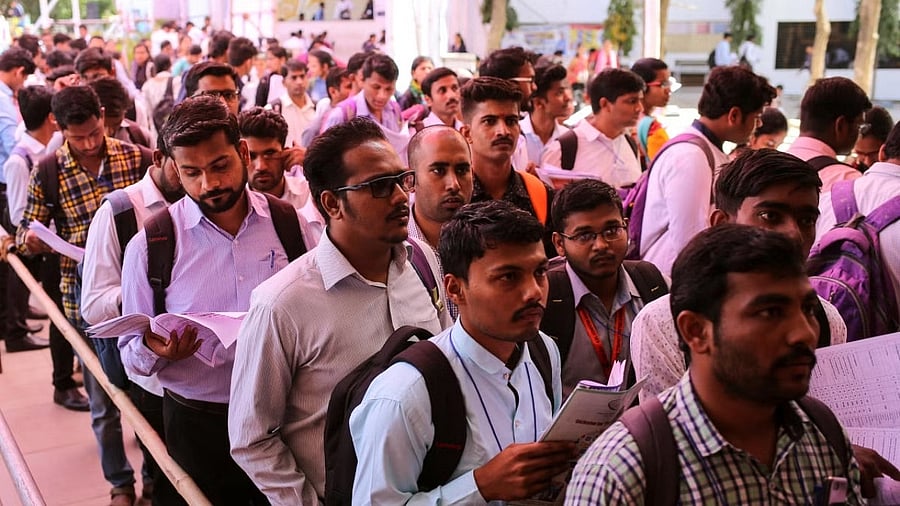
Youth unemployment has surged by 2.5 times between 2012 and 2019, rising from 9 million to approximately 24 million individuals.
Credit: Reuters Photo
The Indian economy currently faces a critical phase of development marked by a concerning stagnation in the structural transformation of employment. This stagnation has resulted in alarming levels of unemployment and an increasing number of youth falling into the “Not in Employment, Education, and Training (NEET)” category. Consequently, the Discouraged Labour Force (DLF) may expand, consisting of educated youths who remain available for employment but have stopped actively searching for jobs due to unfavourable labour market conditions (Parida et al, 2023).
Data from the Periodic Labour Force Survey (PLFS) and National Sample Survey (NSS) underscore the gravity of the situation. Youth unemployment has surged by 2.5 times between 2012 and 2019, rising from 9 million to approximately 24 million individuals. Within this staggering figure, 19 million are male and 5 million are female (Parida et al., 2023).
Moreover, the rising DLF is also a concerning factor for the Indian economy. The number of DLFs has increased from 1 million to 4.5 million between 2011–12 and 2017–18. However, there was a declining trend in DLF from 4.5 million to 2 million during 2017–18 and 2020–21. Within this declining trend of DLF, 2 million were male and 0.5 million were female during the same period. In the post-Covid era, the DLF numbers again started rising tremendously, increasing from 2 million to 2.8 million from 2020–21 to 2021–22. The male DLF increased from 1.7 million to 2.2 million, while the female DLF increased from 0.3 to 0.6 million during the same period.
This alarming trend is exacerbated by India’s current demographic surplus, a unique occurrence expected to cease by 2040, ultimately leading to an aging society.
The issue of DLF is particularly severe in Madhya Pradesh, Chhattisgarh, Bihar, Maharashtra, Uttar Pradesh, West Bengal, and Punjab (Parida et al., 2023). These states have struggled to create sufficient non-farm sector jobs due to limited industrialization, which may be a primary driver of elevated unemployment rates.
The DLF rate among youths exhibits a “U”-shaped pattern concerning their level of education and training. It is highest among those with only primary education or who are illiterate. The DLF decreases with increasing levels of general education but starts to rise again beyond the higher secondary level. Graduates and those with higher levels of education also face a higher DLF rate. Notably, technically trained youth have a slightly lower DLF rate than their generically educated counterparts, but formally vocationally trained youth experience a significantly higher DLF rate compared to both generically educated and technically trained youth.
Additionally, the DLF of women is lower across general education levels but reverses in the case of technical and vocational training.
Several micro-level factors influence an individual’s likelihood of being unemployed and discouraged from joining the labour force. One crucial factor is the daily wage rate, which negatively impacts both unemployment and DLF status among educated youth. This suggests that low and stagnant wage rates partially contribute to the increasing numbers of discouraged individuals and the unemployed in India. Another significant factor is the standard of living of one’s family; those from higher economic classes are more likely to afford DLF, while those from lower economic classes are less likely to stay out of the labour force.
One surprising revelation is that graduates and individuals with higher levels of general education have a higher predicted probability of falling into the DLF category. This highlights the existing labour market disequilibrium, indicating a lack of demand for such highly educated youth.
The combination of rising open unemployment, stagnant real wages, economic disparities, and the prevailing social-cultural context has created a negative environment that discourages educated youth from entering the labour force even after completing their education and training. The challenge posed by this situation is expected to worsen in the post-Covid-19 growth crisis period as the youth population continues to rise.
In this context, the role of industrial development becomes paramount. The synergy between non-farm sector output and employment growth cannot be achieved without the development of the industrial sector in India. Therefore, the implementation of a comprehensive industrial policy aimed at boosting industrial development and addressing skill-related issues is imperative. Such measures can potentially unlock the demographic dividend in India by enhancing labour productivity in the long run.
(Pattayat is asst. professor, Department of Economics, Christ (Deemed to be University), Bengaluru. Mohammed is pursuing PhD in the Dept. of Economics, Shiv Nadar University)